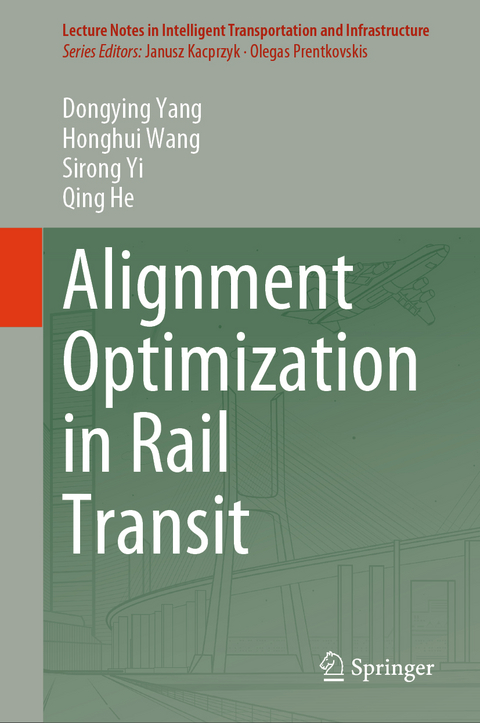
Alignment Optimization in Rail Transit
Springer International Publishing (Verlag)
978-3-031-80560-8 (ISBN)
- Noch nicht erschienen - erscheint am 11.03.2025
- Versandkostenfrei
- Auch auf Rechnung
- Artikel merken
This book deals with alignment optimization models for planning rail transit. After a general introduction to the basics of alignment optimization theory, it presents different alignment optimization methods to deal with different situations. It shows how to set up a 3D GIS scene for alignment interaction design, including location calculation of an alignment, alignment expression in a 3D scene, and the spacial relations between geographic objects, horizontal alignment, and vertical alignment. Further, it presents methods for solving more complex alignment optimization models, and shows for each different rail transit situation, how to calculate investment, energy consumption, and environmental influence. All in all, this book offers an interesting and timely reading to both researchers and professionals in the field of optimization theory, transportation planning, and GIS.
Dongying Yang was born in Zhengzhou, Henan, China, in 1983. He received the B.S. degree from the School of Civil Engineering, Shijiazhuang Railway University at Shijiazhuang, Hebei, China, in 2007, and the M.S. and Ph.D. degrees from the School of Civil Engineering, Southwest Jiaotong University, Chengdu, Sichuan, China, in 2010 and 2022. He was a Deputy General Designer in some urban rail transits, including Line 11 in Shenzhen, China, LRT in Addis Ababa, Ethiopia, and LRT connecting Cario and the new capital, Egypt from 2010 to 2016. Currently, he serves as an associate professor within the Department of Artificial Intelligence, Chengdu University of Technology. His current research interests include computer-aided alignment design, three-dimensional GIS, and railway alignment optimization.
Honghui Wang was born in Xiaogan, Hubei, China, in 1985. He received the B.S., M.S., and Ph.D. degrees in electronic engineering from Chengdu University of Technology in 2007, 2009, and 2012, respectively. Researcher at the State Key Laboratory of Geohazard Prevention and Geoenvironment Protection, since 2015, he also was a Visiting Researcher at the University of California at Berkeley, from 2018 to 2019. Currently, he serves as a Professor within the Department of Artificial Intelligence, Chengdu University of Technology. He is the author of two books, more than 70 articles, and more than 30 inventions. His research interests include instruments science and measurements, computer science and application, artificial intelligence, and optical fiber sensing. Prof. Dr. Wang is a member of the China Electronics Society, IEEE, and OPTICA (formerly OSA). He obtained the China Youth Science and Technology Innovation Award in 2007.
Sirong Yi was born in Chengdu, Sichuan, China, in 1957. She received the Ph.D. degree from the School of Civil Engineering, Southwest Jiaotong University, Chengdu, in 2000, where she is currently a professor. She is also group leader of the Civil Engineering Professional Assessment Committee of Higher Education, China. Her lecture on "Route Location Selection" for undergraduates is a nationally qualified course in China. Author of more than ten books and 40 articles, her research interests include: virtual environment, digital railway, intelligent alignment design, and alignment standard study based on dynamics. She was awarded with the National Prominent Educator in 2006.
Qing He (Member, IEEE) received the B.S. and M.S. degrees in electrical engineering from Southwest Jiaotong University and the Ph.D. degree in systems and industrial engineering from The University of Arizona, in 2010. From 2010 to 2012, he was a Post-Doctoral Researcher at the IBM T. J. Watson Research Center. Dr. He has been an Assistant Professor of civil engineering with the University at Buffalo and an Associate Professor of industrial engineering with The State University of New York, since 2012. Currently, Dr He is a professor, Ph.D. supervisor and deputy director of the School of Civil Engineering at Southwest Jiaotong University, and deputy director of the Key Laboratory of High-speed Railway Line Engineering of the Ministry of Education. His main research direction covers Intelligent Railway Route Selection Design and Railway Operation and Maintenance based on Big Data. He serves as deputy associate editor of "IEEE Transactions on Intelligent Transportation Systems", handling editor of "Transportation Research Record", and executive associate editor of "Intelligent Transportation Infrastructure". He is also a member of ASCE and of the editorial board of "ASCE Journal of Transportation Engineering"
Introduction.- Basic Alignment Optimization Models.- Alignment Interactive Design in a 3D Scene.- Single level Optimization of Metro Alignment with Single objective.- Bi level Optimization with Single objective for Railway Alignment.- Bi level and Bi objective Optimization of Railway Alignment in Ecologically Sensitive Area.
| Erscheint lt. Verlag | 11.3.2025 |
|---|---|
| Reihe/Serie | Lecture Notes in Intelligent Transportation and Infrastructure |
| Zusatzinfo | XXI, 181 p. 135 illus., 56 illus. in color. |
| Verlagsort | Cham |
| Sprache | englisch |
| Maße | 155 x 235 mm |
| Themenwelt | Informatik ► Theorie / Studium ► Künstliche Intelligenz / Robotik |
| Mathematik / Informatik ► Mathematik ► Angewandte Mathematik | |
| Technik ► Bauwesen | |
| Schlagworte | Alignment Optimization Models • Bi-level Optimization • Energy-saving Optimization • Horizontal Alignment • Multi-Objective Optimization • Population-based Algorithms • Single-level Optimization • Three-dimensional GIS • Vertical Alignment |
| ISBN-10 | 3-031-80560-7 / 3031805607 |
| ISBN-13 | 978-3-031-80560-8 / 9783031805608 |
| Zustand | Neuware |
| Informationen gemäß Produktsicherheitsverordnung (GPSR) | |
| Haben Sie eine Frage zum Produkt? |
aus dem Bereich


